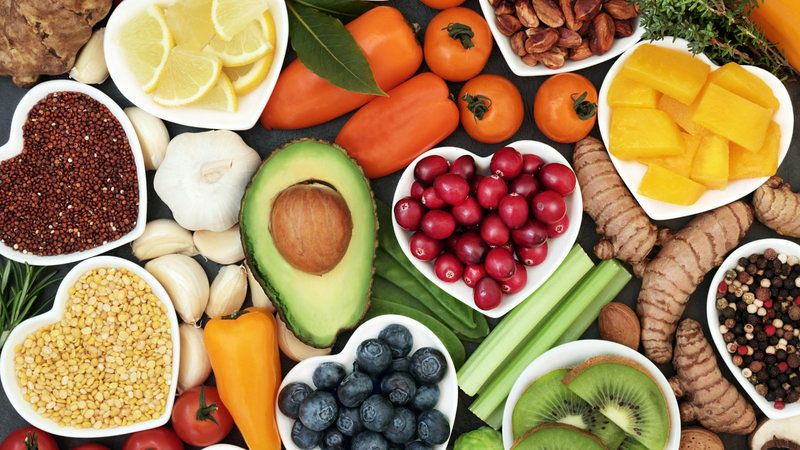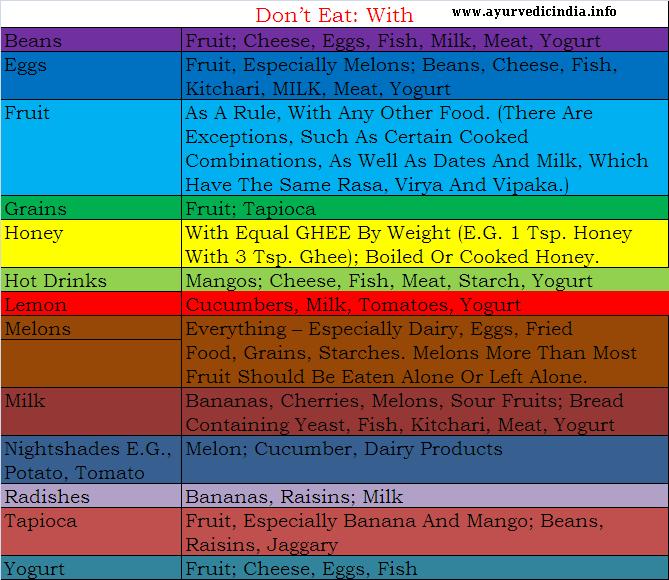Incompatible Foods – What Is It? Ayurveda Tips, What To eat?
Incompatible foods or food combining is a topic which has gained increasing awareness it is not more than a decade in the 1800s (decade) people came across to.

But Ayurveda, an ancient holistic science of healing, has determined a Food combining diet based upon the elements of an individual’s constitution for more than 5000 years ago.
However, it became more popular these days among dieticians and weight loss programmers. Food combining is an art (science) of preparing meals with foods that have the same digestive requirements eaten together in one meal.
Food combining is also known as “trophology” is a term for a nutritional approach that advocates specific combinations of foods that are good for health.
In the modern world, today people are used to eating a variety of foods that normally do not digest well together (e.g. fruits with nuts or beans with cheese) regardless of their habits or particular symptoms that may invite various diseases.
Ayurvedic View on Balanced Diet
According to Ayurveda, we all have been born with a unique constitution. These unique combinations are the three doshas known as Vata, pitta, and Kapha.
As per Ayurveda, these three principles govern the function of our bodies on the physical, mental, and emotional levels. Any imbalance of any of the doshas may result in various diseases by the presence of ama or toxic food products (the food that has not been fully digested).
Ayurveda believes that understanding the person’s unique combination (Vata, pitta, and Kapha) is the key way to find a best-balanced diet.
Ayurveda teaches that the gastric fire or so-called “Agni” in the digestive tract and stomach are the main gateways through which nutrients enter the tissues and then pass along the individual cells to maintain vital functions of the body.
Ayurvedic View on food combining
According to Ayurveda food combining theory, each food has its own taste (rasa) of its own. Some have a heating or cooling energy (Virya) while others have a post-digestive effect (Vipaka) and some even have an inexplicable effect (Prabhava).
It is believed that a person’s “Agni” determines how good or bad food is digested so food combining is of great importance for health.
When you combine two or more foods that have a different taste, energy, and post-digestive effect “Agni” can become overloaded and inhibition of the enzyme system can result in the production of toxins.
However, these same foods if taken separately it could stimulate Agni to digest more quickly and even help to burn ama.
Bad combining can produce indigestion, fermentation, putrefaction, and formation of gas and if remained for prolonged can lead to toxemia and can result in various diseases.
Food incombining Can Invite Different Diseases
If we eating bananas with milk it can diminish Agni, it changes the intestinal flora and produces toxins that can cause nasal cold, congestion, cough, and allergy.
Although both of these foods taste sweet and have cooling energy their post-digestive effect is very different. Bananas are bitter while milk is sweet this causes confusion in our digestive system and can result in toxins, allergies, and other imbalances.
Same way milk and melons should not be eaten together they both have cooling properties but milk is laxative and diuretic melon.
Milk requires more time for digestion in addition, the stomach acid is needed to digest melon that causes milk to fruition, so Ayurveda does not recommend drinking milk with acidic foods.
These are the basic example of incompatible food combining not only disturb the digestion but also cause confusion in the intelligence of our cells that can lead to many different diseases. Below are the charts which can help to see basic food combining.
Ayurveda Food Combining Chart

Ayurveda Food Combining- A Simple Basic Rules
- Do not eat protein and starch together: Our body requires an acid-base to digest protein and an alkaline base to digest starch. Proteins and starches combine well with vegetables and green leaves but non-starchy vegetables do not combine well together.
- Eat single fruits or with other fruits: Fruits must be eaten alone or with other fruits. If fruits are very sweet eat a handful of nuts after some time(approx ratio of 80% fruit, 20% nuts)As fruits digest quickly they are almost digested by the time nuts reach the stomach, and if they combine with each other it may rot and get ferment.
- Never eat melons with any other foods or fruits: As melons digest faster than all other foods they should never be consumed with any other food, even with any other fruits.
- Never eat acidic fruits with any other sub-acidic sweet fruits: Acidic fruits such as pineapple, grapefruit, and strawberries can be eaten with other sub-acidic fruits such as apples, peaches, and grapes. But one must remember not to mix with sub-acid sweet fruits such as bananas, dates, or raisins.
- Never eat fats and oils with fruits: Fats and oils combine well with everything (except fruit) they should be used in limited amounts because they are very caloric which may slow down digestion. Therefore, keep your heavy meal with fat early or allow your body at least 4-5 hours to digest a heavy meal before eating again.
- Never consume two meals in close intervals: Food must be consumed two hours after eating fruits, three hours after eating starches, and four hours after eating proteins.
How to Fix Incombining of Food
- If you eat protein and starch in the same meal, eat some legumes.
- If you eat nuts, eat acid fruit such as pineapple, strawberries with them.
- If you eat dairy products, be sure to eat acidic fruit.
- If you’ve been overloaded with pasta, eat an apple in next morning.
- If you have eaten too much protein, eating papaya the next morning will be helpful.
- If you have eaten too much sugar eat grapes in next morning.
- If you have eaten too much salt, eat watermelon in next morning.
Please don’t get too stressed by these rules. A healthy fit body has a strong digestive fire and can process even incompatible combinations.
In short, if you exercise regularly your stomach tends to have a strong digestive fire in general, young person’s pitta constitutions have a strong digestive fire so no need to worry.
Neglecting your digestive capacity and continuing the use of unsuitable combinations may eventually harm your digestive system. More often digestive upset may cause toxic accumulation of ama and may invite disease.
“The key to live healthy life is to eat with awareness and always maintain a balanced perspective regarding their diet and lifestyle”.



























Don’t burden your digestive system by eating too full.Ayurveda does not suggests over-eating it’s rule say take half-stomach solid food, fill a quarter with water and leave the rest free. This is best for proper digestion.